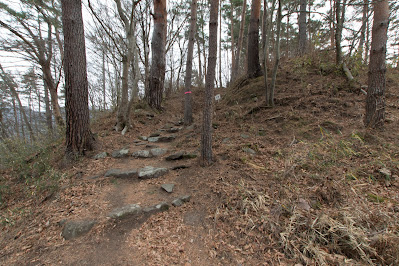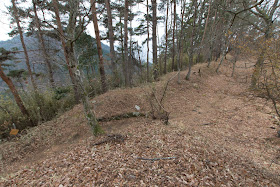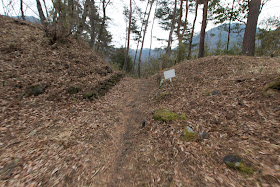Yougaisan Castle
-Returned King Lear-
Overview
Name: Yogaisan castle / Yougaisan castle (Yogaisan-jo / Yougaisan-jo)
Alias: Sekisuiji-jo (Sekisuiji-castle)
Place: Kamisekisuiji-cho, Kofu city, Yamanashi
Type: Mountain castle
Built: Around 1520
Remaining remnants: Stone walls, clay walls and dry moats
Title: 100 more famous Japanese castles
Brief History
Yogaisan Castle (要害山城) is located at Yogaisan mountain, a mountain about three kilometer north of Tsutsujigasaki palace, residence of Takeda clan. As Tsutsujigasaki palace was a traditional simple palace having only little defense facility, Yogaisan castle was built as a shelter place in case of attack.
Other warlords evolved from the governor of Muromachi Shogunate, such as Imagawa clan at Suruga province or Ouchi clan at Nagato province, also had traditional palace and shelter castle built on close mountain separately. Yougaiyama castle and Tsutsujigasaki palace were built by Nobutora Takeda (1493-1574), father of famous warlord Shingen Takeda (1521-1573).
Takeda clan before Nobutora
Takeda clan was a traditional clan stem from Yoshimitsu Minamoto (1045-1127) , nicknamed as Shinra Saburo Yoshimitsu. In 12th century, they were appointed as a governor of Kai country (Yamanashi prefecture) by Kamakura shogunate, and governed the country.
But in Muromachi era, due to the death of current leader at the revolt of Zenshu Uesugi in 1416, the power of the clan significantly decreased and Atobe clan, a house of deputy governor, substantially grasped the country. But from the last quarter of
15th century, leaders of Takeda clan grew their power again and restored their situation.
Nobutora Takeda succeeded the leader position 1507. At that time Takeda clan was surrounded by many non obedient local lords and external powers, but Nobutora desperately fought with them and increased his power. At first Nobutora fought with Oi clan, a large local lord of western Kai province. After the struggle Nobutora made treatment with Oi clan in superior position, and married with daughter of Oi clan.
Unification of Kai province
She became the mother of Shingen Takeda and called as princess Oi. Nobutora also fought with Oyamada clan, a large local lord located in Gunnai area (east part of Yamanashi prefecture), and also made them surrender. Along with centralization of the country, Nobutora also moved his residence from Isawa area to Kofu area, and built Tsutsujigasaki palace and Yogaisan castle around 1520.
Due to the surrender of Oi clan, Imagawa clan which lost connection to Kai province, invaded Kai province by themselves. Imagawa clan attacked newly built Kofu town, and princess Oi had to escape to Yogaisan castle. During her stay at this castle Shingen was born, thus this castle is known as a birthplace of Shingen. Finally Nobutora defeated Imagawa clan at the battle of Kamijyogawara, and stoke back their attack.
As a result, Nobutora united Kai province and transformed Takeda clan from traditional governor into warlord. Nobutora also promoted small retainers to general, and many of senior generals later known as “24 famous generals of Takeda clan” were promoted under Nobutora. At the same time, Nobutora made peace with his long time enemy Imagawa clan and stabilized its southern border.
Due to centralization and military preparation, now it was ready for Takeda clan to expand to outside the province.
Structure of Yougaiyama castle
Yougaiyama castle is built on a mountain shaped half cut meet pie. Because of thin mountain body, over 20 terraces continues from hillside to hilltop in line. Size of each terrace is considerably large considering being built in the former half of 16th century, and some terraces exceeds 50 meter long.
Central area is a rectangular area of 80 meter long and 30 meter wide, and places at the highest point of the mountain. It is surrounded by tall clay wall, and has front gate and backside gate at its west and east line.
At its front side, many terraces are built digging the slope. Each area is separated by sheer slope, and route from lower area does not climb directly but once folded to another side and climb to next area, to attack the enemy from upper side. At important terrace there are gates secured stone walls, probably built after the fall of Takeda clan. Generally front side of the castle is built to place the soldier and make counter attack to enemy.
Contrary to this, backside of the central area at its east direction, is planned to block the intrusion of enemy by any means. Backside area is connected by narrow path with virtical dry moat at the both side of clay bridge, and body of some clay bridge and dry moat are secured by stone wall. Total length of the castle is over 500 meter, and might be the longest castle in Yamanashi prefecture.
Expulsion by his son
But continuous fights with local retainers or external powers and rapid centralization evoked dissatisfaction in the country. In addition to this, Nobutora had a character of arbitrary decision, and it was suitable to unite the divided province but not appropriate to manage it. Furthermore, continuous poor crop might damage his authority. Later Nobutora was said to be cruel to justify the following coup d’etat, but this might be a propaganda affected by old Chinese story. But anyway, people of Kai province demanded a change of atmosphere.
Nobutora had many sons, and at first he planned to succeed to Harunobu Takeda (later Shingen), his eldest son. But later Nobutora favored Nobushige Takeda (1525-1561), the second eldest brother and planned to change the position. This evoked confusion in the clan, and at last in 1541, when Nobutora visited Imagawa clan at Suruga province (eastern part of Shizuoka prefecture), Shingen and major retainers shut the border and refused return of Nobutora. There was mostly no confusion from this coup d’etat, and Shingen smoothly succeeded his authority. Nobushige himself had supported Shingen from first, and he served as a loyal vice leader of Takeda clan.
Wandering and return
After exile, Nobutora stayed Suruga province for a while, because Takeda clan and Imagawa clan had alliance. Around 1560 Nobutora moved to Kyoto as Shingen’s wife was a daughter of noble family in Kyoto, stayed there and served to Muromachi Shogunate as a former governor of Muromachi Shogunate.
However, Shingen became hostile against Nobunaga Oda (1534-1582) who dominated Kyoto around 1572, and situation of Nobutora became unstable. In 1573 Shingen died during the campaign against Nobunaga, and in that year Nobunaga expelled Yoshiaki Asikaga (1537-1598), last shogun, and Muromachi Shogunate came an end.
Facing such situation, as Shingen already died, Nobutora decided to return to Takeda territory. Current leader Katsuyori Takeda (1546-1582), a grand son of Nobutora, did not allow him to enter Kai province, but also could not leave him, thus Nobutora lived at Takato castle in Shinano province. Nobutora stayed a few months there and died in ill. Even if short time, it might be relief for him to live in the territory of Takeda clan unlike King Lear.
Afterward of castle
Yogaisan castle had been used for the period of Takeda clan, and once Katsuyori moved his residence to Shinpu castle, governors after Takeda clan used Kofu city as capital again. Among the unstable situation after the fall of Takeda clan, these governors considered Yogaisan castle as a last resort and reformed it by new technology.
After the completion of Kofu castle, both Tsutsujigasaki palace and Yogaisan castle were abolished. Now shapes of each areas almost completely remain on the steep mountain, and looking down on Tsutsujigasaki palace and Kofu city. It will be tired by arrival to central area, but structure of backside area is also worth seeing and it is recommended to advance a little more.
Access
Entrance of mountain places at the side of Hotel Yougai of Sekisuji Spa at the north of Tsutsujigasaki palace (Takeda shrine). It in necessary to walk 30 minutes from Takeda shrine, thus it might be recommended to use taxi or rental bicycle from JR East Chuo Honsen line Kofu station. 30 minutes drive from Chuo Expressway Kofushowa interchange.
Related Castles
Tsutsujigasaki Palace -Residence of "Tiger of Kai"-
Shinpu Castle -Castle built by tragic successor of Takeda clan-
Kofu Castle -Multilayered stone walls guarded Edo city-











































































































































































































































































No comments:
Post a Comment